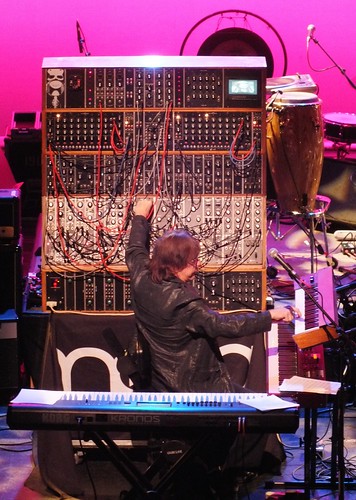Club sounds, conversations; could be real, could be recorded. Hard to say, actually. Music almost in the background, but as the bass drones start to take over my attention the club seems to fade away and we slowly take off, almost as if it’s the soundtrack to an otherwise silent airship journey. Not sure what I was expecting, perhaps bleeps and bloops, sequencers run amok. Hadn’t expected this slow rise above the landscape though.
Even the simple single-note lines seem to be full of texture. Thick with reverb, moving in, out, around us, pulling us onward. For some reason I expected robots, what I got was deep humanity. And then those organ tones come in, hypnotic in their warbling timbre and surprising just on the fact of their existence. And hey, perhaps some percussive bleeps and bloops along with the organ. Finally! Everything here is synthetic, but also wholly organic. Slow, gracious, calm, beauteous. Robots with human hands, human hands wrangling robots. Pure single held note. Then, surprisingly modulated, beyond expectation. Then key change sneaking up on us, and we’re into Part 2.
The beat takes over, feels like it’s speeding up, although that might only be because our head’s now nodding along to the rhythm. Vaguely plinky-plunky Japanese somehow, but now a different organ grounds us. Not church style, not jazz style, but there almost as pure texture. Incredibly refreshing because you’re just so jazzed it’s not synth strings the way it always is. (Note to self: Organ!) It’s hypnotizing, in its peacefulness, still propelled by that great beat. Keep having to remind myself it’s live, and the further in I get the more I wish I’d been there.
And of course, just as you’re comfortable, key change. Baseline has me hooked. Head again bopping along. Changes coming fast and furious, yet somehow slowly and calmly at the same time. It’s evolution, somehow musically expressed. Wait a second, when did those drums come in? All of a sudden they’re there, except it happened somehow slowly, over time. Yeah, I’m hooked. Dagnabbit, major change happened again! But this time it’s that I only just noticed the drums have disappeared.
And then the thickest of thin buzzy textures take us into Part 3, where we find ourselves in the land of slow and peaceful texture. Eyes closed, soaking it in, knowing we’ll get there, to some other place, almost without noticing the change.
Yup, just as I predicted. Somehow, indeed unnoticed, we’re in the middle of treated pianos, and it somehow wasn’t even a surprise now that we’re here.
Yes, now Part 4. Distinctly different from Part 3, but a transition so smooth you might not have noticed. That quiet stick tip tattoo finding its mates, over time becoming another propulsive rhythm, moving us along. And yet we’re still also deep in the slow reverb, now joined by staccato synth lines, echoed clean, forming a backbone for yet another kind of utterly organic organ, filling the space with still more texture. The rhythm is infectious, it’s got me going. Just right. Drums, sequencers, reverb, echo, organ. It’s all there.
I started listening and writing in daylight, now it’s full dark, the only light coming from my screen as I type. But if I close my eyes I can see the lights flow by on the sequencer, see the (synthetic) Leslie spinning, see all the heads bobbing along with mine. Man, if only I’d known. Would’ve been great to see this done live instead of just listening in headphones in iTunes.
And even as we slowly go from joyful head bopping into full on creep-out chaos right there at the end I just had to almost laugh along with it all. Fantastic. Was sorry it was over, but also relieved I could finally let go of the breath I’d been holding the whole time. Hadn’t even noticed I’d been on the edge of my seat, was completely immersed.













